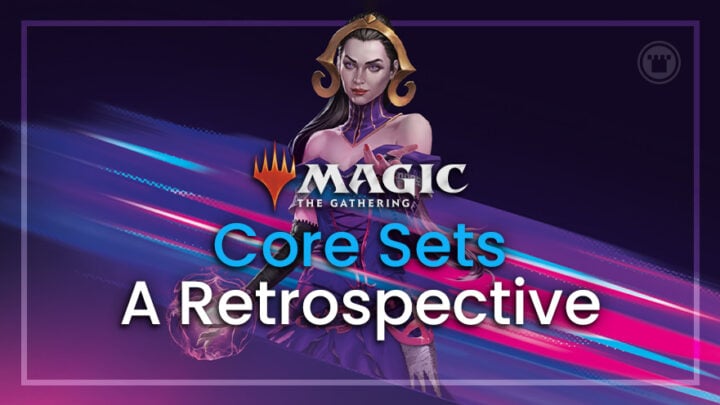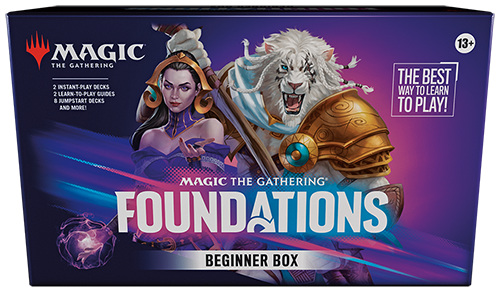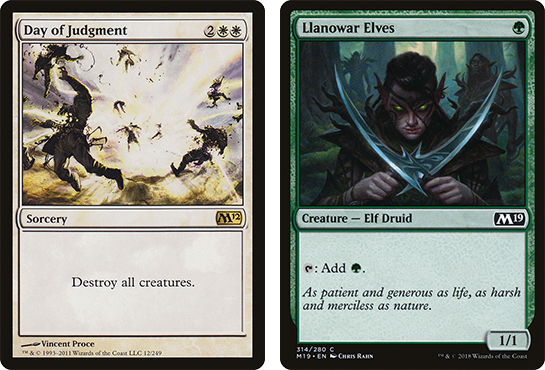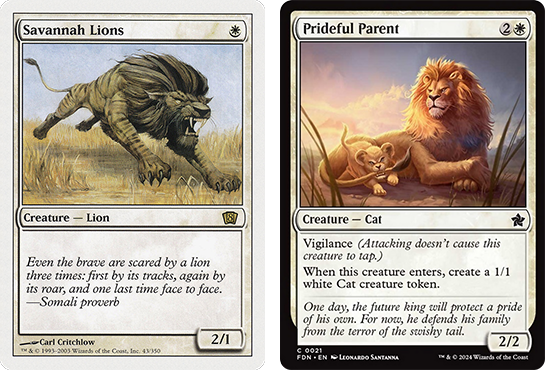Foundations releases on November 15th [EDITOR – Card Kingdom’s Presale is live now!]. With its release we’re getting the most recent iteration of a Magic: the Gathering core set and this one is nothing short of revolutionary. However, core sets have been around since (almost) the beginning, and they’ve undergone several major changes over the years. In this article, I’m going to trace the history of these core sets so that you can get a feel for where Foundations fits in the history of this type of product.
WHAT IS A CORE SET?
We haven’t had a Core Set since the release of Core Set 2021, so if you’re a newer player you may not even know what a core set is, so let me explain.
Throughout Magic history, core sets have had two main goals. First, they are intended to be for beginners. Core set cards tend to be simpler than cards you see in other releases. This makes them an excellent on-ramp for new players, who otherwise might be intimidated by modern Magic design’s tendency to load text boxes with dozens of words.
Second, core sets are intended to be a base set for the Standard format. They tend to contain a much higher percentage of reprints than most sets. The cards that are chosen to be reprinted tend to be cards that have had a major impact on past Magic formats. In other words, core sets allow Wizards of the Coast the ability to curate the Standard format significantly more than typical Standard-release sets.
It also gives them significantly more freedom in those Standard-release sets, since they don’t have to make sure to include things like mana elves and 4-mana board sweepers when they’re readily available in the core set.
We’ve only seen a little bit of Foundations so far, but we’ve already seen some cards that have been core set all-stars – like Llanowar Elves and Day of Judgment.
LIMITED EDITION, REVISED, and MAGIC’S FIRST CORE SET
Sometimes, you’ll hear Limited Edition Alpha called Magic’s first core set, but I don’t think that’s correct. This is because it didn’t have the same goal that core sets have. How could it? When it was released it was simply Magic. The same is true of Limited Edition Beta, which is simply the second printing of Alpha.
When Alpha and Beta came out in 1993, the idea of subsequent sets wasn’t even in mind. Remember, when Arabian Nights was being designed they were at first planning on making it a standalone game.
In other words, neither Alpha nor Beta could be core sets because they were never intended to be a base set for a broader game. They were just Magic.
Unlimited has a more legitimate claim as a “core set.” It was released in December of 1993 with the purpose of getting reprints of Limited Edition cards into the hands of newer players. So, it was a product intended for beginners. However, tournament Magic wasn’t really a thing, so it wasn’t done with the specific purpose of curating the Standard format.
In the end, I think we should consider Revised (released in 1994) the first true core set. By then, Wizards of the Coast had created officially sanctioned Magic: the Gathering tournaments. Now, they were interested in curating the format to make it more balanced. They did this through the creation of the DCI and the banned and restricted list, but they also did this with Revised.
Revised removed broken cards like the Power 9 and added in reprints from Magic’s first two expansions – Arabian Nights and Antiquities.
REPRINT-ONLY CORE SETS (1994-2009)
Revised set the precedent for what a core set would be for a decade and a half. In all, eight core sets were released between 1994 and 2009 and every single one of them was entirely made up of reprints. These reprints were carefully chosen. After all, they didn’t want to reprint cards that had broken Standard, like Strip Mine or Tolarian Academy.
They did want to reprint cards that were both simple and viewed as staples. Of course, simple didn’t always mean a card wasn’t powerful. After all, Wrath of God and Counterspell were mainstays of core sets for much of this era.
CORE SETS WITH UNIQUE CARDS (2009-2014)
In 2009, Core Sets underwent a major shake-up. That year’s Magic 2010 was the first core set to include mechanically unique cards. Of the set’s 249 cards, 111 of them (44%) were brand new.
However, while this change was certainly notable, the overall goal of core sets didn’t change. While there were new cards printed, they were still designed with new players in mind. In other words, the set still featured simpler card designs than a typical Standard-release set.
Overall, this change was well-received. It made the set far more interesting for enfranchised players, since they could now get their hands on some new cards, while still catering to new players.
Over time, Core Sets included fewer and fewer reprints. This also resulted in cards becoming more complex, although they still tried to keep the complexity level low. The last Core Set of this era, Magic Origins had 272 cards, 181 of which (67%) were not reprints.
CORE SETS ARE PHASED OUT
In 2014, Mark Rosewater wrote an article about the end of Core Sets. In it, he explains that Core Sets now occupied a strange no man’s land. R & D just wasn’t sure who core sets were for any more.
With complexity and the number of unique cards in Core Sets on the rise, MaRo and other designers began to feel that core sets were no longer all that beginner friendly. And the sets weren’t for advanced players either, since they were still holding back when it came to design.
As MaRo put it, “The core set has an identity problem. It’s trying to make two different audiences happy at the same time and it’s led to us making a set full of very odd compromises.”
While there were some other factors involved, including wanting to make the Magic story permeate all products and not really having the release slot for a core set, it was this issue about a core set’s audience that ultimately led them to retiring them for several years.
In their place were Planeswalker Decks, precons associated with each release that were intended to introduce players to the game. These decks featured a face planeswalker and a deck built around them. These were met with lukewarm reviews as best, as the decks and their face planeswalkers tended to be underpowered and uninteresting.
CHARACTER-FOCUSED CORE SETS (2018-2020)
In 2018, MaRo wrote an article about the return of core sets. The main impetus for this was the failure of the Planeswalker Decks, with R & D concluding that a trading card game’s introductory product should probably have randomized booster packs rather than preconstructed decks.
In the three years without them, R & D realized that Core Sets were important for Magic. However, they also realized they needed to do things a little bit differently going forward. The biggest change was that these new core sets would have flavorful themes.
Earlier core sets, even after they ceased being reprint-only products, tended to be very vanilla. While this was partly a symptom of the intentional simplicity of core sets, it was also because there was no story tying the set’s cards together. WotC realized that they could more effectively use core sets to introduce players to the flavor of Magic just as much as its gameplay, and that this might solve some of the problems earlier core sets had.
This focus on Magic lore would be the biggest hallmark of the Core Sets released between 2018 and 2020, with each of them focusing on one major character from the Magic story.
Core Set 2019 was all about the arch-villain elder dragon planeswalker Nicol Bolas. Core Set 2020 was focused on the planeswalker pyromancer Chandra Nalaar. And Core Set 2021 was about Teferi, the planeswalker time mage.
CORE SETS ARE PHASED OUT AGAIN
Adventures in the Forgotten Realms began design as a Dungeons & Dragons-themed Core Set, but during design the team moved away from this, because they wanted the set to feel mechanically unique to better reflect the world of D&D. This wasn’t something you could do within the confines of a core set.
This, combined with the fact that more and more players were being introduced to the game via Commander, led to a shift in strategy when it came to introductory products. Since 2020’s Zendikar Rising, every Magic release comes with Commander preconstructed decks.
Jumpstart products were also introduced in 2020. With these, a player simply had to purchase two boosters and shuffle them together to make a 40-card deck that could be played against someone else who had done the same thing. This took away the complexity of deckbuilding altogether, while still letting a player experience Magic gameplay.
FOUNDATIONS – THE “EVERGREEN” CORE SET
At first blush, Foundations doesn’t seem all that different from the core sets that came before. After all, it’s about half reprints and half new cards, and it’s intended to be a beginner product that establishes a base set for the Standard format. But there’s one massive difference with Foundations – it’s not rotating any time soon, with Wizards of the Coast calling it an “evergreen” core set.
Foundations is intended to be legal in Standard until at least 2029. That’s what makes this new core set’s name particularly apt. You don’t have to worry about having the floor pulled out from under you with Foundations cards, because they are going to remain part of the format for the long term.
Wizards of the Coast is planning on reprinting the set every year too, that way it remains an easily accessible introductory product for the foreseeable future.
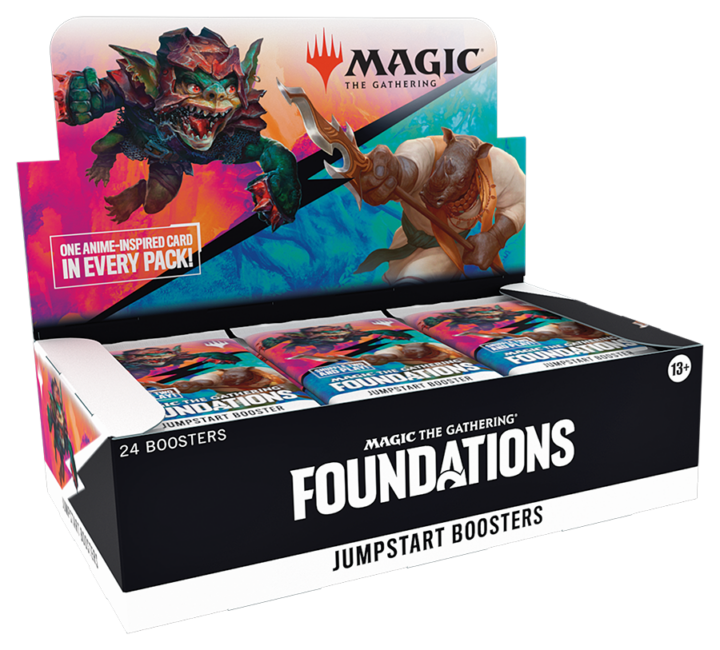
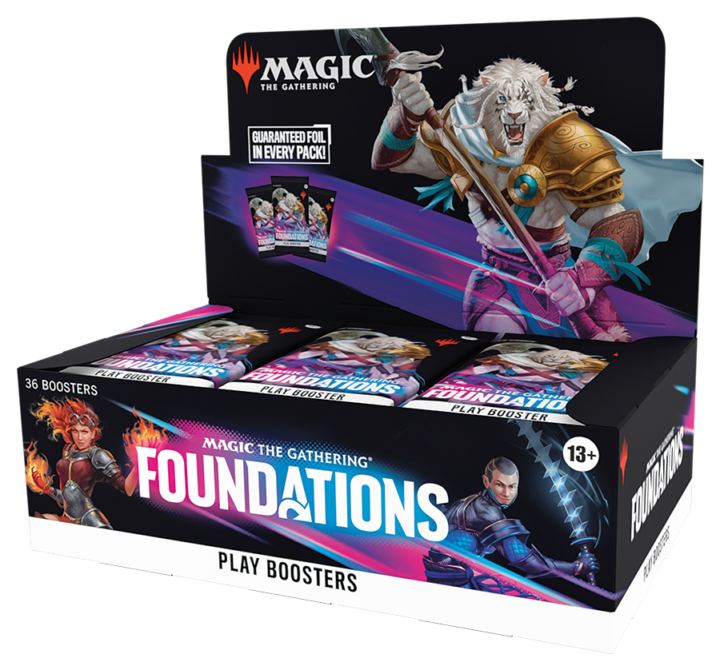
Additionally, Foundations looks to solve the identity problem of other core sets. This is because the set contains many different products. This will include Jumpstart booster packs and a “Beginner Box” for beginners, and Play Boosters for more experienced players. The beginner products will have significantly simpler cards, while the Play Boosters will up the complexity level.
END STEP
It’s going to be fascinating to see what impact Foundations has on Standard. Not allowing cards to rotate for so long is an entirely new idea. Do you think Foundations will have the intended impact on the Standard format? Let me know your take over on X!

Jacob has been playing Magic for the better part of 24 years, and he especially loves playing Magic’s Limited formats. He also holds a PhD in history from the University of Oklahoma. In 2015, he started his YouTube channel, “Nizzahon Magic,” where he combines his interests with many videos covering Magic’s competitive history. When he’s not playing Magic or making Magic content, he can be found teaching college-level history courses or caring for a menagerie of pets with his wife.

